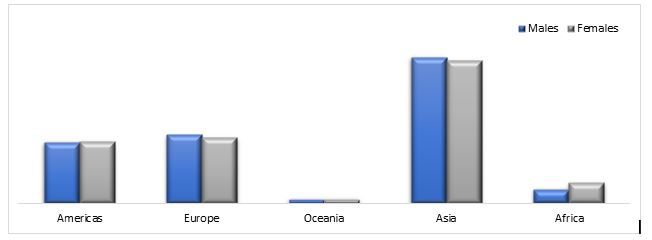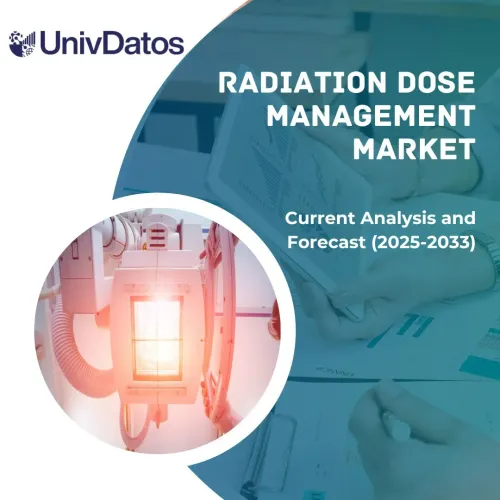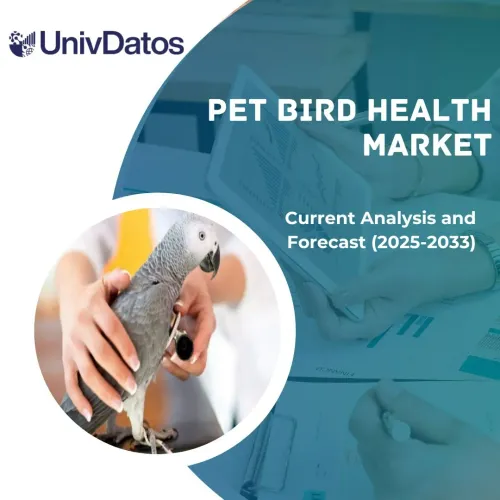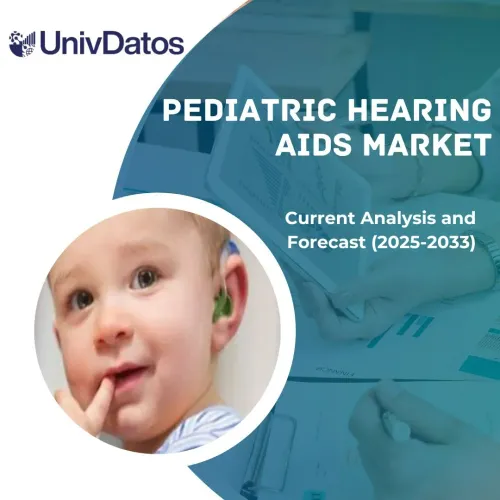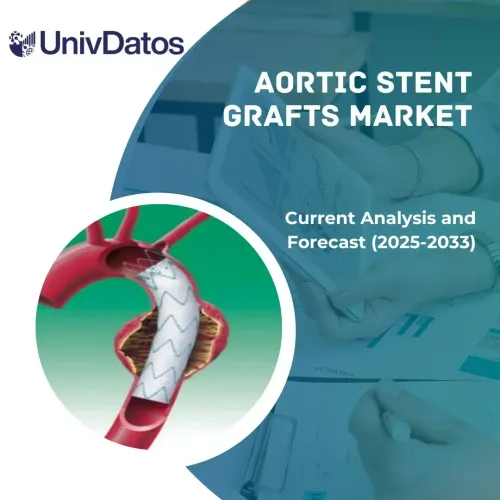- Home
- About Us
- Industry
- Services
- Reading
- Contact Us
Next-Generation Sequencing Market: Current Analysis and Forecast (2021-2027)
Emphasis on Product/Services (Consumables, Systems & Software, Services); Technology (SBS, SMRT, Pyrosequencing, Ion Semiconductor Sequencing, Nanopore Sequencing, Others); Application (Diagnostics, Biomarkers & Cancer, Drug Discovery, Personalized Medicine, Agriculture & Animal Research, Others); End-User (Pharma Companies, Biotechnology Companies, Academic & Government Institutes, Clinical Research, Others); and Region & Country.
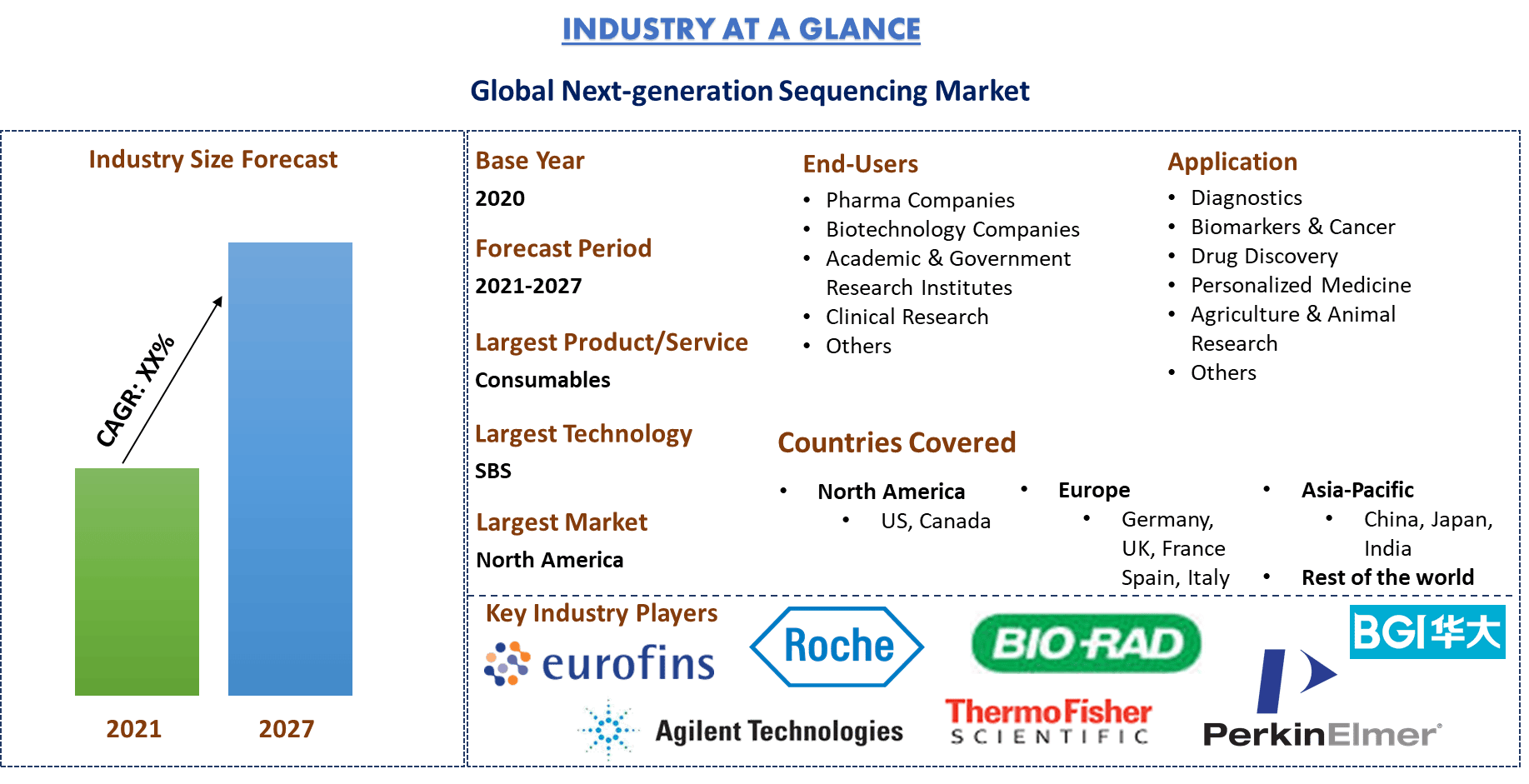
Next-Generation Sequencing Market was valued at ~US$ 8 billion in 2020 and is expected to grow at a CAGR of ~19% over the forecast period (2021-2027). Next-generation sequencing (NGS) is a technology used to determine the RNA or DNA sequence to study genetic variation associated with various types of diseases or other biological phenomena. This method was introduced for commercial use in 2005 and was initially known as massively-parallel sequencing as it enables the sequencing of several DNA strands at the same time. NGS provides the ideal throughput per run, and studies can be performed quickly and cost-effectively.
The NGS market is growing exponentially on account of rapid advancements in NGS technology, rising cancer incidences, and increasing applications of NGS in various sectors. Further, the study of genomics is attracting attention from investors as well as from the public as it impacts the very core of lives and all living things around the globe. Completing the sequencing of the first human genome in 2003 was a key breakthrough that took over 10 years and cost approximately USD 3 billion. Since then, the sequencing speed of a genome has more than doubled, significantly outpacing Moore’s Law. Today’s high throughput sequencing machines process the human genome in a matter of hours at a cost approaching USD 1,000. These advancements have allowed researchers to analyze the genome in less time, greatly increasing the pace of scientific discovery
Furthermore, the rise in cancer incidences and reduced sequencing costs is anticipated to boost the market growth. The cost of whole-genome sequencing has dropped promptly over the last decade with the emergence of next-generation sequencing. Additionally, the increasing government-funded initiatives are further propelling the growth of the NGS market across the globe. For instance, recently in 2020, the Department of Biotechnology (DBT) initiated the ambitious “Genome India Project” (GIP) to collect 10,000 genetic samples of citizens across India to build a reference genome. The precision health, rare genetic disorders, mutation spectrum of genetic and complex diseases in the Indian population, genetic epidemiology of multifactorial lifestyle diseases, and translational research are some of the priority areas of this project.
Distribution of Cancer Incidence Worldwide (%), 2020, By Gender
Illumina, Thermo Fisher Scientific, QIAGEN, Agilent Technologies, Bio-Rad Laboratories, F. Hoffmann-La Roche, BGI, Oxford Nanopore Technologies, PerkinElmer, and Eurofins Scientific are some of the prominent players operating in the global next-generation sequencing market. Several M&A’s along with partnerships have been undertaken by these players to by these players to develop new and advanced NGS platforms.
Insights Presented in the Report
“Amongst product/services, consumables segment holds the major share”
 Based on the product/services type, the market is fragmented into consumables, systems & software, and services. The consumables segment dominated the market with a share of XX% in 2020 and is expected to maintain its dominance during the forecast period owing to the increasing number of sequencing procedures worldwide. However, the services segment is also expected to grow at the highest CAGR of XX% during the projected timeframe to reach market valuation at USD XX million by 2027. The growth of this segment is attributed to the growing adoption of NGS-based diagnostics and the need for better data management services for storing a huge amount of generated data
Based on the product/services type, the market is fragmented into consumables, systems & software, and services. The consumables segment dominated the market with a share of XX% in 2020 and is expected to maintain its dominance during the forecast period owing to the increasing number of sequencing procedures worldwide. However, the services segment is also expected to grow at the highest CAGR of XX% during the projected timeframe to reach market valuation at USD XX million by 2027. The growth of this segment is attributed to the growing adoption of NGS-based diagnostics and the need for better data management services for storing a huge amount of generated data
“Amongst technology, SBS dominated the market in 2020”
Based on technology, the market is fragmented into SBS, SMRT, pyrosequencing, Ion semiconductor sequencing, nanopore sequencing, and others. The SBS segment generated revenue of USD XX million in 2020. The market is expected to grow at a CAGR of XX% during the forecast period to reach a market valuation of USD XX million by 2027F. This segment is expected to grow as Illumina sequencing technology, sequencing by synthesis (SBS) is widely adopted NGS technology across the world. For instance, SBS technology is responsible for generating more than 90% of the world’s sequencing data. Further, the increase in the availability of NGS platforms based on SBS is driving the growth of the segment
“Amongst application, Biomarkers & Cancer is anticipated to grow at the highest CAGR during the analyzed period”
Based on application, the market is fragmented into diagnostics, biomarkers & cancer, drug discovery, personalized medicine, agriculture & animal research, and others. The biomarkers & cancer segment generated revenue of USD XX million in 2020. The market is expected to grow at a CAGR of XX% during the forecast period to reach a market valuation of USD XX million by 2027F owing to the rising incidences of cancer all over the world. However, the personalized medicine segment is expected to grow at the highest CAGR of XX% between 2021-2027F as many researchers are focusing on identifying & monitoring different biomarkers that can be later used for developing efficient personalized medicine. For instance, as per the recent study published in July 2020, scientists are developing a multi-analyte test strip that can be used for monitoring even the slightest change in the biomarker profile of a patient. This technology will combine big-data analytics and advanced technologies such as wearables for ensuring the continuous acquisition of precise data.
Amongst end-user, academic & government research institutes segment holds the major share”
Based on end-users, the market is fragmented into pharma companies, biotechnology companies, academic & government institutes, clinical research, and others. The academic & government research institutes segment generated revenue of USD XX million in 2020. The market is expected to grow at a CAGR of XX% during the forecast period to reach a market valuation of USD XX million by 2027F owing to the growing number of collaborations between key industry players of NGS and academic research institutes. For instance, in 2019, Illumina and the Broad Institute of MIT and Harvard collaborated for the co-development of secondary genomic analysis algorithms and software.
“North America signifies one of the largest markets of next-generation sequencing Market”
For a better understanding of the market dynamics of the next-generation sequencing market, a detailed analysis was conducted for different regions across the globe including North America (United States, Canada, and the Rest of North America), Europe (Germany, France, Italy, Spain, United Kingdom and Rest of Europe), Asia-Pacific (China, Japan, India, and Rest of APAC), Rest of World has been conducted. North America dominated the market and generated revenue of USD XX million in 2020 owing to the increasing cancer incidence and higher government-funded initiatives. At the same time, Asia-Pacific is anticipated to grow at the highest CAGR of XX% during the forecast period.
Reasons to buy this report:
- The study includes market sizing and forecasting analysis validated by authenticated key industry experts
- The report presents a quick review of overall industry performance at one glance
- The report covers an in-depth analysis of prominent industry peers with a primary focus on key business financials, product portfolio, expansion strategies, and recent developments
- Detailed examination of drivers, restraints, key trends, and opportunities prevailing in the industry
- The study comprehensively covers the market across different segments
- Deep dive regional level analysis of the industry
Customization Options:
The next-generation sequencing market can further be customized as per the requirement or any other market segment. Besides this, UMI understands that you may have your own business needs, hence feel free to connect with us to get a report that completely suits your requirements.
Table of Content
Analyzing the historical market, estimation of the current market, and forecasting the future market of the Global Next-generation Sequencing Market were the three major steps undertaken to create and analyze the adoption of NGS for the different diseases across major regions globally. Exhaustive secondary research was conducted to collect the historical market numbers and estimate the current market size. Secondly, to validate these insights, numerous findings and assumptions were taken into consideration. Moreover, exhaustive primary interviews were also conducted, with industry experts across the value chain of the next-generation sequencing technology. Post assumption and validation of market numbers through primary interviews, we employed a top-down/bottom-up approach to forecast the complete market size. Thereafter, market breakdown and data triangulation methods were adopted to estimate and analyze the market size of segments and sub-segments the industry pertains to. Detailed methodology is explained below:
Analysis of Historical Market Size
Step 1: In-Depth Study of Secondary Sources:
Detailed secondary study was conducted to obtain the historical market size of the next-generation sequencing market through company internal sources such as annual report & financial statements, performance presentations, press releases, etc., and external sources including journals, news & articles, government publications, competitor publications, sector reports, third-party database, and other credible publications.
Step 2: Market Segmentation:
After obtaining the historical market size of the next-generation sequencing market, we conducted a detailed secondary analysis to gather historical market insights and share for different segments for major regions. Major segments included in the report are product/services, technology, application, and end-user. Further country-level analyses were conducted to evaluate the overall utilization of next-generation sequencing in every region.
Step 3: Factor Analysis:
After acquiring the historical market size of different segments and sub-segments, we conducted a detailed factor analysis to estimate the current market size of next-generation sequencing market. Further, we conducted factor analysis using dependent and independent variables such as increasing cancer incidence and rising government funded initiatives. A thorough analysis was conducted for demand and supply-side scenario considering top partnerships, merger and acquisition, business expansion, and product launches in the next-generation sequencing industry across the globe.
Current Market Size Estimate & Forecast
Current Market Sizing: Based on actionable insights from the above 3 steps, we arrived at the current market size, key players in the next-generation sequencing market, and market shares of the segments. All the required percentage shares split, and market breakdowns were determined using the above-mentioned secondary approach and were verified through primary interviews.
Estimation & Forecasting: For market estimation and forecast, weights were assigned to different factors including drivers & trends, restraints, and opportunities available for the stakeholders. After analyzing these factors, relevant forecasting techniques i.e. top-down/bottom-up approach was applied to arrive at the market forecast about 2027 for different segments and subsegments across the major markets globally. The research methodology adopted to estimate the market size encompasses:
- The industry’s market size, in terms of value (USD) and the utilization rate of next-generation sequencing across the major markets domestically
- All percentage shares, splits, and breakdowns of market segments and sub-segments
- Key players in the next-generation sequencing market in terms of services offered. Also, the growth strategies adopted by these players to compete in the fast-growing market
Market Size and Share Validation
Primary Research: In-depth interviews were conducted with the Key Opinion Leaders (KOLs) including Top Level Executives (CXO/VPs, Sales Head, Marketing Head, Operational Head, and Regional Head, Country Head, etc.) across major regions. Primary research findings were then summarized, and statistical analysis was performed to prove the stated hypothesis. Inputs from primary research were consolidated with secondary findings, hence turning information into actionable insights.
Split of Primary Participants in Different Regions
Market Engineering
Data triangulation technique was employed to complete the overall market estimation and to arrive at precise statistical numbers of each segment and sub-segment of the next-generation sequencing market. Data was split into several segments & sub-segments post studying various parameters and trends in the areas of product/services, technology, application, and end-user of the next-generation sequencing market.
Main Objective of the Next-generation Sequencing Market Study
The current & future market trends of next-generation sequencing were pinpointed in the study. Investors can gain strategic insights to base their discretion for investments from the qualitative and quantitative analysis performed in the study. Current and future market trends were determined the overall attractiveness of the market at a regional level, providing a platform for the industrial participant to exploit the untapped market to benefit as a first-mover advantage. Other quantitative goals of the studies include:
- Analyze the current and forecast market size of next-generation sequencing in terms of value (USD). Also, analyze the current and forecast market size of different segments and sub-segments
- Segments in the study include areas of product/services, technology, application, and end-user
- Define and analysis of the regulatory framework for the next-generation sequencing industry
- Analyze the value chain involved with the presence of various intermediaries, along with analyzing customer and competitor behaviors of the industry
- Analyze the current and forecast market size of the next-generation sequencing market for the major region
- Major regions studied in the report include North America (the United States and Canada), Europe (Germany, France, Italy, Spain, and United Kingdom), Asia-Pacific (China, Japan, India), and Rest of the World
- Company profiles of the next-generation sequencing market and the growth strategies adopted by the market players to sustain in the fast-growing market
- Deep dive regional level analysis of the industry
Related Reports
Customers who bought this item also bought

